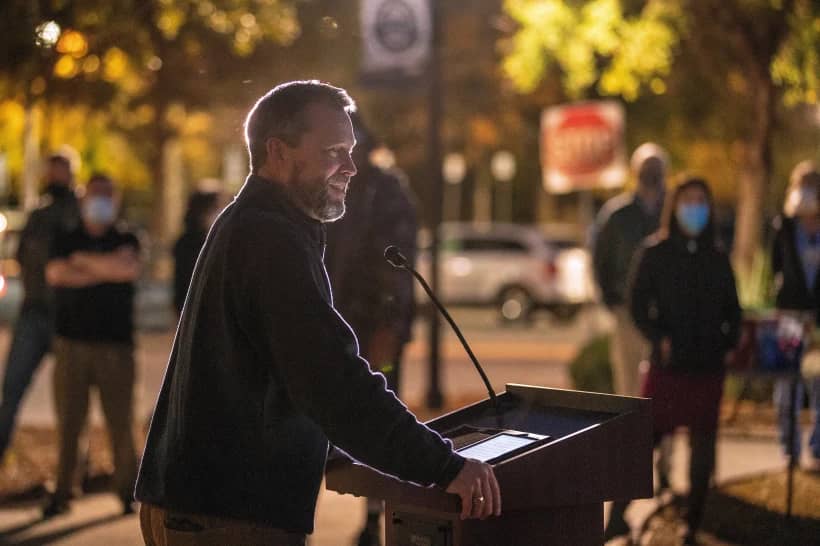KEARNEY, Nebraska — Father Art Faesser considers his living room his sanctuary. A small crucifix hangs on the wall.
So, too, does an elaborate Sioux dress, a cradle board, drums, a buffalo head and dozens of authentic pieces from the Lakota Sioux Reservation in South Dakota.
These artifacts extend into every room of his house. He’s been acquiring them for 30 years from native Lakota Sioux artists because they convey a spiritual significance.
“Of all my experiences in the priesthood, seeing what we’d done to the native people gave me a great passion to find small ways to raise their sense of dignity and human worth,” Faesser, a retired priest who assists at St. James Catholic Church, said.
Father Art likes to say, “That drum beat got me into it at a very early age.”
In the spring of 1952, he was just 3 years old when he, his brother Vic, 5, and their immigrant parents stepped off a train in Ogallala with about $25 in cash, two suitcases and a wooden trunk built by his father, a carpenter.
Although the family was German, they came to the U.S. from Russia, where they had taught Russians how to farm. In Ogallala, they were met by their sponsor, George McGinley. “Immigrants were required to have a sponsor to provide lodging, food, jobs and so forth,” Faesser said.
In the 1950s, there was no interstate highway, but Highway 30 went through many small towns, and several had what Faesser humorously called “tourist traps” to entertain travelers.
Ogallala’s was the Sioux Trading Post, owned by the Henline family. Every summer, three generations of the Lakota Henry Whitecalf family came down from the Pine Ridge Reservation to put on an evening powwow at the Sioux Trading Post.
In the afternoon, Henry Whitecalf would drive the pickup through town, beating on the drum as his granddaughter danced, hoping to entice tourists to the powwow.
The dances were held behind a gift shop “full of stuff made in China,” Faesser said. Teepees were set up, and the Whitecalf family would perform and take up a collection from the tourists to pay their living expenses.
“That drumbeat was the heartbeat of Mother Earth. I heard that drum beat. That entered my spirit and stayed with me,” Faesser said.
After being ordained in 1976, Faesser was assigned to Holy Rosary Church in Alliance, a railroad town with a sizeable Native American population “who lived south of the tracks, in dire poverty. There were many elderly natives who lived in one room on a dirt floor with a single potbelly stove. My heart went out to them,” he said.
Five years later, he was assigned to churches in Rushville and Hay Springs, which bordered South Dakota’s Pine Ridge Reservation. He was there for six years.
“Natives would come down from the rez and sell blocks of cheese and canned meats so they could buy alcohol. We had done that to them. We put them on non-productive reservation land, gave them minimum check payments and asked that they eke out a minimal living. They turned to alcoholism,” he said.
“Sometimes, they would come to the door and ask for food. I would give them food, but to give them a sense of human dignity, I would ask them to pick up litter or twigs in the church yard,” he said.
Some people came two or three times a week, especially in the summer. He got to know some of them. “One man in his mid-to-late 20s looked like he was in his 40s because his face was so disfigured from alcoholism. I’d sit on the front porch with him. He was quiet. Sometimes we’d just sit together in silence,” Faesser said.
Faesser became increasingly troubled by what he saw and experienced.
“This engaged my passion for the plight of the native people. Of all my experiences in the priesthood, seeing what we’d done to the native people gave me a great passion to find small ways to raise their dignity and human worth,” he said.
In 1991, he was assigned to the Newman Center at the University of Nebraska at Kearney. When he had time off, Faesser would travel to Rapid City. “I loved Rapid City. It became my mecca for native art and culture,” he said.
The first piece he bought was a plain drum. “I loved that drum, its heartbeat. I’d hear it when I went to powwows at the Pine Ridge or in the Black Hills,” he said.
Soon he became friends with the natives who made those items. He was invited to sweat lodges and ceremonies. He has attended two Sun Dances, which are multi-day ceremonies conducted by a medicine man. “They left a deep mark on me.”
To Faesser, the Sun Dance resembles the liturgy of Good Friday. A tree is cut down and prayed over during the ceremony. Thongs are attached to it.
“The ceremony represents suffering and redemption. People commit to fasting. They pray for relatives, for the nation (“the hoop”) and their culture, their way of life and more,” he said.
“Lakota Sioux art carries a great deal of spiritual meaning for me. It invited me to enter into a fuller and deeper understanding of the spirituality of the Plains people,” he said.
The Catholic church currently has one Native American saint, but a Lakota Sioux member, Black Elk, is being considered for the sainthood. “Black Elk saw parallels between Catholicism and blended that with native spirituality,” he said. Faesser sees them, too.
Traveling to Rapid City frequently, Faesser got to know many native artists. He has met gallery owners like Ray Hillenbrand, a Michigan native who took over a century-old building in Rapid City and employed native artists and sold their work.
One of Faesser’s pieces, a buffalo skull, came from the sale table at a shop called Prairie Edge. If pieces didn’t move, they would be marked down and placed on the Prairie Edge sale table. “That brought them within my reach. A number of my pieces came from there,” he said.
He also commissioned pieces, such as a hide that hangs on his living room wall, decorated by artist Frank Shortie. “Three years later, he finished that piece. I’ve had that for 27 years,” Faesser said.
Faesser understood that the gallery owners had thin profit markets. “They had to pay salaries, utilities, insurance. A commissioned piece enabled me to collect some very fine pieces at a price that I could afford,” he said.
Faesser retired in 2019, but he continues to return to Rapid City and purchase keepsakes. “I cannot go up to Rapid City and not bring something back. I’d drive through the rez and see shacks, no trees, just one lone pine tree. I’d witness the poverty, the people walking down the highways,” he said.
“I think the government has made efforts to right some of the wrongs, but we’re not honoring our treaties,” he added.
He said some native people have become successful lawyers and medical people, “but those success stories aren’t as widespread as they could be,” he said.
Faesser — who, ironically, lives on Sioux Lane — considers his living room and its displays of bonnets, warrior shirts, a beaded elk dress, a buffalo headdress and more, his “prayer room.”
“I’m surrounded by pieces that do not grow old. They are more beautiful each day. When I sit there and start looking at these pieces, I have a sense of being overwhelmed. Together with my prayer, the richness of the beauty of being surrounded by this kind of art nurtures my spirit.”











